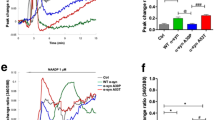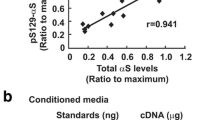Abstract
Intraneuronal deposition containing α-synuclein is implicated in the pathogenesis of synucleinopathies including Parkinsons disease (PD). Although it has been demonstrated that cytoplasmic inclusions of wild type α-synuclein are observed in the brain of PD patients and that α-synuclein mutations such as A30P and A53T accelerate aggregate formation, the exact mechanism by which α-synuclein forms insoluble aggregates is still controversial. In the present study, to understand the possible involvement of tissue transglutaminase (tTG) in aggregate formation of a-synuclein, SH-SY5Y cell lines stably expressing wild type or mutant (A30P or A53T) a-synuclein were created and aggregate formation of α-synuclein was observed upon activation of tTG. The data demonstrated that a-synuclein negligibly interacted with tTG and that activation of tTG did not result in the aggregate formation of a-synuclein in SH-SY5Y cells overexpressing either wild type or mutant a-synuclein. In addition, a-synuclein was not modified by activated tTGin situ. These data suggest that tTG is unlikely to be a contributing factor to the formation of aggregates of α-synuclein in a stable cell model.
Similar content being viewed by others
References
Andringa, G., Lam, K. Y., Chegary, M., Wang, X., Chase, T. N., and Bennett, M. C., Tissue transglutaminase catalyzes the formation of alpha-synuclein crosslinks in Parkinson’s disease.FASEB J., 18, 932–934 (2004).
Conway, K. A., Harper, J. D., and Lansbury, P. T., Accelerated in vitro fibril formation by a mutant alpha-synuclein linked to early-onset Parkinson disease.Nat. Med., 4, 1318–1320 (1998).
Conway, K. A., Lee, S. J., Rochet, J. C., Ding, T. T., Williamson, R. E., and Lansbury, P. T., Jr. Acceleration of oligomerization, not fibrillization, is a shared property of both alpha-synuclein mutations linked to early-onset Parkinson’s disease: implications for pathogenesis and therapy.Proc. Natl. Acad. Sci. U.S.A., 97, 571–576 (2000).
Davidson, W. S., Jonas, A., Clayton, D. F., and George, J. M., Stabilization of alpha-synuclein secondary structure upon binding to synthetic membranes.J. Biol. Chem., 273, 9443–9449 (1998).
Folk, J. E., Mechanism and basis for specificity of transglutaminase-catalyzed epsilon-(gamma-glutamyl) lysine bond formation.Adv. Enzymol. Relat. Areas Mol. Biol., 54, 1–56 (1983).
Galvin, J. E., Lee, V. M., and Trojanowski, J. Q., Synucleinopathies: clinical and pathological implications.Arch. Neurol., 58, 186–190 (2001).
Giasson, B. I., Uryu, K., Trojanowski, J. Q., and Lee, V. M., Mutant and wild type human alpha-synucleins assemble into elongated filaments with distinct morphologies in vitro.J. Biol. Chem., 21A, 7619–7622 (1999).
Green, H., Human genetic diseases due to codon reiteration: relationship to an evolutionary mechanism [letter].Cell, 74, 955–956 (1993).
Greenberg, C. S., Birckbichler, P. J., and Rice, R. H., Transglutaminases: multifunctional cross-linking enzymes that stabilize tissues.FASEBJ., 5, 3071–3077 (1991).
Ho, G. J., Gregory, E. J., Smimova, I. V., Zoubine, M. N., and Festoff, B. W., Cross-linking of beta-amyloid protein precursor catalyzed by tissue transglutaminase.FEBS Lett., 349, 151–154 (1994).
Junn, E., Ronchetti, R. D., Quezado, M. M., Kim, S. Y., and Mouradian, M. M., Tissue transglutaminase-induced aggregation of alpha-synuclein: Implications for Lewy body formation in Parkinson’s disease and dementia with Lewy bodies.Proc. Natl Acad. Sci. U.S.A., 100, 2047–2052 (2003).
Kanda, S., Bishop, J. F., Eglitis, M. A., Yang, Y., and Mouradian, M. M., Enhanced vulnerability to oxidative stress by alpha synuclein mutations and C-terminal truncation.Neuroscience 97, 279–284 (2000).
Karpuj, M. V., Garren, H., Slunt, H., Price, D. L., Gusella, J., Becher, M. W., and Steinman, L., Transglutaminase aggregates huntingtin into nonamyloidogenic polymers, and its enzymatic activity increases in Huntington’s disease brain nuclei.Proc. Natl. Acad. Sci. U.S.A., 96, 7388–7393 (1999).
Ko, L., Mehta, N. D., Farrer, M., Easson, C., Hussey, J., Yen, S., Hardy, J., and Yen, S. H., Sensitization of neuronal cells to oxidative stress with mutated human alpha-synuclein.J. Neurochem., 75, 2546–2554 (2000).
Krishnan, S., Chi, E. Y., Wood, S. J., Kendrick, B. S., Li, C., Garzon-Rodriguez, W., Wypych, J., Randolph, T. W., Narhi, L. O., Biere, A. L., Citron, M., and Carpenter, J. F., Oxidative dimer formation is the critical rate-limiting step for Parkinson’s disease alpha-synuclein fibrillogenesis.Biochemistry, 42, 829–837 (2003).
Kruger, R., Kuhn, W., Muller, T., Woitalla, D., Graeber, M., Kosel, S., Przuntek, H., Epplen, J. T., Schols, L., and Riess, O., Ala30Pro mutation in the gene encoding alpha-synuclein in Parkinson’s disease.Nat. Genet., 18, 106–108 (1998).
Lai, T. S., Slaughter, T. F., Peoples, K. A., Hettasch, J. M., and Greenberg, C. S., Regulation of human tissue transglutaminase function by magnesium-nucleotide complexes. Identification of distinct binding sites for Mg-GTP and Mg-ATP.J. Biol. Chem., 273, 1776–1781 (1998).
Lesort, M., Chun, W., Johnson, G. V., and Ferrante, R. J., Tissue transglutaminase is increased in Huntington’s disease brain.J. Neurochem., 73, 2018–2027 (1999).
Lorand, L. and Conrad, S. M., Transglutaminases.Mol. Cell Biochem., 58, 9–35 (1984).
Lotharius, J. and Brundin, P., Pathogenesis of Parkinson’s disease: dopamine, vesicles and alpha-synuclein.Nat. Rev. Neurosci., 3, 932–942 (2002).
Miller, C. C. and Anderton, B. H., Transglutaminase and the neuronal cytoskeleton in Alzheimer’s disease.J. Neurochem., 46, 1912–1922 (1986).
Miller, M. L. and Johnson, G. V., Transglutaminase cross-linking of the tau protein.J. Neurochem., 65, 1760–1770 (1995).
Narhi, L., Wood, S. J., Steavenson, S., Jiang, Y., Wu, G. M., Anafi, D., Kaufman, S. A., Martin, F., Sitney, K., Denis, P., Louis, J. C., Wypych, J., Biere, A. L., and Citron, M., Both familial Parkinson’s disease mutations accelerate alphasynuclein aggregation.J. Biol. Chem., 274, 9843–9846 (1999).
Olanow, C. W. and Tatton, W. G., Etiology and pathogenesis of Parkinson’s disease.Annu. Rev. Neurosci., 22, 123–144 (1999).
Ostrerova-Golts, N., Petrucelli, L., Hardy, J., Lee, J. M., Farer, M., and Wolozin, B., The A53T alpha-synuclein mutation increases iron-dependent aggregation and toxicity.J. Neurosci., 20, 6048–6054 (2000).
Paik, S. R., Lee, J. H., Kim, D. H., Chang, C. S., and Kim, Y. S., Self-oligomerization of NACP, the precursor protein of the non-amyloid beta/A4 protein (A beta) component of Alzheimer’s disease amyloid, observed in the presence of a C-terminal A beta fragment (residues 25–35).FEBS Lett., 421, 73–76 (1998).
Paxinou, E., Chen, Q., Weisse, M., Giasson, B. I., Norris, E. H., Rueter, S. M., Trojanowski, J. Q., Lee, V. M., and Ischiropoulos, H., Induction of alpha-synuclein aggregation by intracellular nitrative insult.J. Neurosci., 21, 8053–8061 (2001).
Polymeropoulos, M. H., Lavedan, C., Leroy, E., Ide, S. E., Dehejia, A., Dutra, A., Pike, B., Root, H., Rubenstein, J., Boyer, R., Stenroos, E. S., Chandrasekharappa, S., Athanassiadou, A., Papapetropoulos, T., Johnson, W. G., Lazzarini, A. M., Duvoisin, R. C., Dilorio, G., Golbe, L. I., and Nussbaum, R. L., Mutation in the alpha-synuclein gene identified in families with Parkinson’s disease.Science, 276, 2045–2047 (1997).
Selkoe, D. J., Abraham, C., and lhara, Y., Brain transglutaminase:in vitro crosslinking of human neurofilament proteins into insoluble polymers.Proc. Natl. Acad. Sci. U.S.A., 79, 6070–6074 (1982).
Sherer, T. B., Betarbet, R., Stout, A. K., Lund, S., Baptista, M., Panov, A. V., Cookson, M. R., and Greenamyre, J. T., Anin vitro model of Parkinson’s disease: linking mitochondrial impairment to altered alpha-synuclein metabolism and oxidative damage.J. Neurosci., 22, 7006–7015 (2002).
Voiles, M. J. and Lansbury, P. T., Jr., Zeroing in on the pathogenic form of alpha-synuclein and its mechanism of neurotoxicity in Parkinson’s disease.Biochemistry, 42, 7871–7878 (2003).
Weinreb, P. H., Zhen, W., Poon, A. W., Conway, K. A., and Lansbury, P. T., Jr., NACP, a protein implicated in Alzheimer’s disease and learning, is natively unfolded.Biochemistry, 35, 13709–13715 (1996).
Wood, S. J., Wypych, J., Steavenson, S., Louis, J. C., Citron, M., and Biere, A. L., Alpha-synuclein fibrillogenesis is nucleation-dependent. Implications for the pathogenesis of Parkinson’s disease.J. Biol. Chem., 274, 19509–19512 (1999).
Xie, H., Litersky, J. M., Hartigan, J. A., Jope, R. S., and Johnson, G. V., The interrelationship between selective tau phosphorylation and microtubule association.Brain Res., 798, 173–183 (1998).
Zhang, J., Guttmann, R. P., and Johnson, G. V., Tissue transglutaminase is anin situ substrate of calpain: regulation of activity.J. Neurochem., 71, 240–247 (1998a).
Zhang, J., Lesort, M., Guttmann, R. P., and Johnson, G. V., Modulation of thein situ activity of tissue transglutaminase by calcium and GTP.J. Biol. Chem., 273, 2288–2295 (1998b).
Zourlidou, A., Payne-Smith, M. D., and Latchman, D. S., Modulation of cell death by alpha-synuclein is stimulusdependent in mammalian cells.Neurosci. Lett., 340, 234–238 (2003).
Author information
Authors and Affiliations
Corresponding author
Rights and permissions
About this article
Cite this article
Suh, MD., Park, CH., Kim, SS. et al. Tissue transglutaminase is not involved in the aggregate formation of stably expressed α-synuclein in sh-sy5y human neuroblastoma cells. Arch Pharm Res 27, 850–856 (2004). https://doi.org/10.1007/BF02980178
Received:
Issue Date:
DOI: https://doi.org/10.1007/BF02980178




